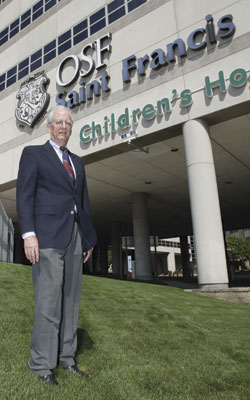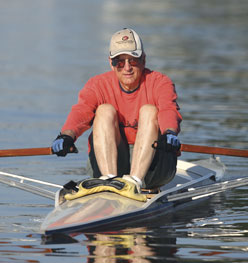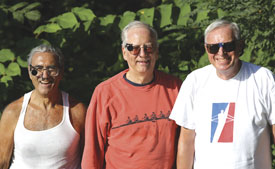After receiving his medical degree from the University of Illinois in 1967, Dr. Tim Miller then served two years in the Army Medical Corps, one of which he spent in Vietnam. He completed his fellowship in neonatology at the University of Louisville School of Medicine in 1973 and joined the department of pediatrics at OSF Saint Francis Medical Center as founder and director of the Neonatal Intensive Care Unit. Under his leadership, the NICU at OSF Saint Francis grew to become one of the largest in the Midwest, with a staff of five full-time neonatologists and a full range of tertiary neonatal services.
Dr. Miller has served as Chief Medical Officer and Director of Medical and Academic Affairs at OSF Saint Francis since 1995. As such, he is the liaison between the hospital and its large medical staff and is responsible for credentialing physicians, staff discipline, administration of medical education programs and compliance and quality improvement issues affecting physicians. Among Dr. Miller’s top interests are patient safety, the value and costs of graduate medical education programs and monitoring the quality of care. In his spare time, Dr. Miller enjoys rowing at sunrise on the Illinois River and spending time with his wife, children and grandchildren.

Tell about your educational background and your career path which led to your current position.
I attended both the University of Illinois in pre-med studies—attaining a BS in Liberal Arts, Philosophy—and the University of Illinois College of Medicine in Chicago. In 1967, I received my MD in Chicago; this was three years before legislation was passed opening the new medical campuses in Rockford, Urbana and Peoria.
I then did a rotating internship at St. Joseph’s Hospital in South Bend, Indiana, before entering the Army, after which I spent one year in Vietnam and a second at Fort Ord, California. By then, I had decided to become a pediatrician, and I did my first year of advanced training here in Peoria at OSF Saint Francis Medical Center. Having been exposed at this time to the newly-developed field of neonatology—the care of newborn and premature infants—I then went to Louisville, Kentucky to finish my training under Dr. Billy Andrews, one of the “fathers” of neonatology.
I returned to OSF Saint Francis Medical Center as the second pediatric sub-specialist in Peoria. Pediatric Cardiologist Dr. William Albers was the first. I was fortunate to be able to develop the existing premature nursery (established as one of the earliest in the nation) into a modern Neonatal Intensive Care Unit (NICU).
After serving as the director of the NICU for 22 years, I was asked in 1995 to become the second director of medical and academic affairs by the administrative team here at OSF Saint Francis Medical Center, and I have held that position for over 12 years.
Who or what influenced you to become a pediatrician?
I was influenced to become a pediatrician and neonatologist by:
- Dr. William Albers, who helped solidify the pediatric training program here at OSF Saint Francis, but encouraged me to complete this training in Louisville where I could then attain a fellowship in neonatology.
- Dr. Billy Andrews, who taught me not only the skills of NICU care, but also introduced me to the importance of “regionalizing” this care, and the necessity of “keeping score” on the outcomes of NICU care.
- My wife, Karlene, who was a neonatal nurse when we were married.
- My parents, Bob and Dorothy, who were continually encouraging me to pursue medicine as a career, and who continue to do so as they approach their 70th wedding anniversary.
You served in the U.S. Army Medical Corps. What did your work there consist of and how is it different from standard medical practice in hospitals?
I was a General Medical Officer (GMO) in Vietnam and was assigned as a battalion surgeon near the DMZ (demilitarized zone). This assignment was for general medical support, but it taught me the importance of Med-Evac to MASH hospitals. In fact, these same principles are integral to the care of sick newborns, children and adults, and are the model by which OSF Saint Francis Medical Center has become an academic, regional referral center.
Tell about your current responsibilities as Medical Director at OSF. What is a typical day at the office like for you?
As mentioned previously, I am only the second “Medical Director” officially designated to this position at OSF Saint Francis. The office was established in the early 1980s by Dr. Donald Rager—who later became one of the regional deans at UICOMP—and grew out of the increasing complexities of modern medicine. My responsibilities include sub-specialization of care, assurance for adequate credentialing of over 1,000 medical providers on the medical staff, and growth of the Sisters’ collaboration with UICOMP as a major Academic Medical Center in expanding to 12 programs with over 160 residents and fellows-in-training. These are the precursors of what is now described in large centers as Chief Medical Officer.
A day in the office consists of working closely with the administrative team to adapt to the almost daily changes inherent in the complexities of providing care in a large organization of 16 medical departments and 23 patient care units. In addition, I am always attending meetings as the liaison between administration and the medical and academic departments.
What areas of responsibility does neonatology entail that the broader pediatrics specialty does not?
Neonatology is the specialized care of high-risk newborn infants and involves approximately seven to 10 percent of all newborn babies. This includes those who are either born prematurely, have some significant form of birth defect or are otherwise affected with illnesses such as infections, lung, brain, heart or kidney malfunction.
You helped establish the Neonatal Intensive Care Unit (NICU) at the Children’s Hospital. How has the NICU grown since its beginning?
When I arrived at Saint Francis Medical Center in 1973, the care of premature infants was in its own infancy. The Sisters were some of the first outside of Chicago to support a Premature Infant Station. However, care was limited to providing: 1) warm environments (incubators), 2) expertise in feeding infants through feeding tubes, and 3) giving antibiotics for newly acquired infections.
This unit has now grown into one of the finest NICUs in the nation, as measured by outcome studies provided by the Vermont Oxford worldwide NICU data network. Incubators are now “open” for easy access for both nurses and families, IV fluids are possible for even the tiniest of prematures, and ventilators are sophisticated and commonplace. As an example of this increased sophistication, when I arrived, there was only one monitor available to keep track of the newborns’ breathing rates. The unit now has over 50 monitors to keep track of second-by-second vital signs for every admission. When I got here, there were six electrical outlets in a room caring for six babies. Today, there are 16 outlets available for each of the eight infants in each room.
In addition, many with birth defects can now be corrected surgically, either by our pediatric surgeons or our congenital heart surgery team. Feeding tubes are now supplemented by IV fluid regimens which can deliver all of the same nutrients that are available through the mother’s umbilical cord. And finally, new drugs have been developed, including more powerful antibiotics and a new surfactant that can be administered directly into the lungs of a struggling premature infant.

What are some contributing factors to the increase in low birth-weight babies in this area? Nationally?
Unfortunately, in spite of marked advances in care for infants after birth, the incidence of premature delivery in the U.S. has remained difficult to impact. The two most commonly described reasons for this phenomenon have been: 1) the deferring of motherhood until a more advanced maternal age, and 2) the dramatic increase in infertility treatment programs with their associated increase in the occurrence of multiple births. These multiple births, in turn, increase the probability of premature delivery.
You have spent most of your life in central Illinois. What aspects of living and working here have been most attractive to you?
I was born and grew up in Monticello, Illinois—a small rural community 25 miles from Champaign-Urbana. I have always felt that the Midwestern culture and ethic is, and always has been, a necessary buffer to the rapidly changing lifestyle of the east and west coasts. My wife and I have raised three children in central Illinois and have never regretted keeping our roots here.
Can you address the issue of and the reasons behind the shortage of healthcare workers in central Illinois?
There is a shortage of healthcare workers everywhere, not just in central Illinois. The aging of our population and the ability of modern healthcare advances which allow everyone to live longer will continue to place demands on our system to provide more and more human resources to meet that demand.
What is OSF Saint Francis doing to try to recruit and retain physicians and nurses?
Our number-one strategy is to “grow our own.” Our College of Nursing will very soon reach an enrollment of 500 and our physician residency programs have reached an all-time high of over 160. In addition, we are exploring the implications (and costs) of expanding existing programs and adding even more subspecialty (fellowship) programs to our academic mission. What specialty practice do you predict will be most needed in the next five to 10 years?
What specialty practice do you predict will be most needed in the next five to 10 years?
It is almost certain that all specialties, and even, I might add, all primary care practices, will experience increasing demand. Our national health care training organizations are asking for a 30 percent increase in medical student training positions.
Please explain how hospitalists are being used at OSF Saint Francis.
Hospitalists are being utilized by almost every community in the nation. They provide in-house care to patients whose more intense illnesses require adjustments to their care plans almost hourly—not just the historic once-a-day visit from their primary physician. It is becoming increasingly difficult for our excellent primary physicians to meet their office and/or operating room needs, and at the same time provide the supervision of their hospitalized patients. We have both adult and pediatric hospitalists.
What is the most rewarding aspect of your job?
The most rewarding aspect of my current position is to be part of the cohesive administrative team that tries to balance the needs of 5,400 employees and over 1,000 medical staff professionals in meeting the clinical and safety needs of our 25,000 to 26,000 admissions each year. I especially enjoy the opportunity to help provide these needs in an environment which facilitates the training of future physicians and nurses.
Do you have a philosophy which you try to apply to your everyday work?
My philosophy has always been to work out the best way to show that health care is only enhanced for patients when it is provided with the complete cooperation of everyone working as a team.
How and when did you begin your hobby of rowing on the Illinois River?
In growing up, I can always remember watching the Olympics on television, and I noticed the complete engagement (and exhaustion) on the faces of rowers. I bought my first shell (rowing boat) in 1986 and have never considered any other type of “fitness conditioning.” In addition, a peaceful hour on the Illinois River at sunrise is as relaxing as it is rewarding.
What will be the impact of the Milestone Project on the future of OSF Saint Francis Medical Center as a regional academic medical center?
At the present time, one out of every three admissions to the hospital is transferred to Peoria from beyond the Tri-County Area, and we expect this ratio to increase, especially with complex medical services. In preparation for this, we have visited many other benchmark hospitals around the country and we will be incorporating those state-of-the-art ideas into the final building design of our Milestone expansion project. We are very excited about being a part of the largest building project in Peoria’s history. IBI


